Immersive Learning for Lost Architectural Heritage: Interweaving the Past and Present, Physical and Digital in the Monastery of Madre de Deus
Abstract
1. Introduction
1.1. Research Objectives and Knowledge Gaps
1.2. From the Monastery of Madre de Deus to the National Tile Museum
2. Literature Review
2.1. Virtual Heritage Dissemination
2.2. Authenticity in Virtual Reconstruction Research
2.3. Immersive Learning
3. Materials and Methods
3.1. Materials from Previous Virtual Reconstruction Modelling with HBIM
- An “As-Found” Model of the National Tile Museum: This group focused on digitally modelling parts of the National Tile Museum building as they exist. The modelling was conducted primarily through point cloud data collected at a prior date by the professors of the course [1] (pp. 6220–6221). The objective of this group’s work was to accurately model spaces related to what are believed to be the original spaces belonging to the Monastery of Madre de Deus. The model was meant as a comparison against the 16th-century reconstruction. As much as possible, the model replicates the existing conditions to give reference to the physical space, though it was challenging to replicate all the ornate details of the gilded woodcarving and the painted scenes one the tiles that contribute to the building’s character.
- The 16th-century Church—Hypothesis 1: This group delved into the 16th-century church of Madre de Deus by challenging hypotheses established previously by the historians Pais and Curvelo [79]. The historians proposed that the original church’s location be in the present D. Manuel Room due to a literal analysis of the painting “Arrival of the Relics of Saint Auta,” [80] deriving from the 16th century, which shows the river by the church’s south façade. Instead, students contested this arrangement, acknowledging the possibility that the role of the painting was more figurative than literal. This resulted in a shift in orientation of the main façade from the west to the south. They also compared the dimensions of existing point cloud data to measurements found in historic text which outlined the dimensions of the original church. In addition, they speculate that the original portal may have been relocated from a different location as indicated by an unexplained excavation indicated in 19th-century drawings [81]. As a result, the students located the 16th-century church where the Low Choir is located today, rather than the D. Manuel Room as speculated by the historians. This revised proposal would imply a similar layout to what is seen in the Convent of Jesus today, with the choir located west of the main nave.
- The 16th-century Church—Hypothesis 2: This theme tested a previously developed written hypothesis of Madre de Deus’s 16th-century church by João Simões which drew theoretical connections to other architectural examples of the Colettine reform [82]. Simões speculated that the building adhered to architectural precedents found in the Convent of Jesus in Setúbal and the Convent of Saint Clare in Gandía. The students incorporated this perspective, while making slight adjustments to the proportions of the walls based on point cloud data and based on a comparison of historic cartographies. As a result of this proposal, the church would take the place of both the D. Manuel Room and the Low Choir.
- The 16th-century Church—Hypothesis 3: This hypothesis reconstructed the 16th-century Madre de Deus using three reference paintings. Historians entertain the notion that three church paintings initially housed by the church might indeed portray it. This hypothesis explores aligning the façade—“Arrival of the Relics of Saint Auta” [80]—and two interiors—“Saint Francis Delivering the Statutes” [83] and “Tryptic of the Presentation of the Child” [84]. The model adheres to dimensions outlined in a written contract providing measurements from 1517 [85] (p. 76) and measurements from point cloud data.
- Arab Room: The space formerly known as the Arab Room is situated in what is today known as the Chapel of Queen Leonor. This space was known to be part of the original palace space owned by Álvaro da Cunha’s widow and is famous for its wooden Mudéjar ceiling. The rope motif of this ceiling prompted Queen Leonor to establish the monastery upon this existing palace. The theme reconstructed the chapel’s original ambiance, including tile work, floor patterns, and modelling an altar from historic drawings which depict it housed in this space.
- Modelling Nepomuceno’s 19th-century Plans: Following the dissolution of religious orders in 1834, architect José Maria Nepomuceno surveyed the Madre de Deus Monastery for its conversion into a Casa Pia asylum. His plan categorized areas into red (signifying what was to be built), gray (signifying what was found and maintained), and yellow (what was found and planned to be demolished) [81]. These layers’ interpretations provided insights into the building’s evolution, crucial for understanding its chronology. The task involved modelling two interpretations of Nepomuceno’s intervention: what was supposedly built and what was encountered initially. Additionally, these models incorporated present point cloud data to ascertain the surviving remnants of Nepomuceno’s modifications. Due to the analytical approach of this research, it was not deemed essential to experience these two models separately but rather to visualize them as models within the immersive experience.
- Low Choir: The space that is today still known as the Low Choir likely served as the entrance to the pre-existing Mudéjar palace by the Tagus River before becoming a monastery. Its function as a choir after King D. João III’s expansion is clear, but its original role in the 16th century remains uncertain—whether as the original church or choir. This model explores the hypothesis that the space maintains its function as the original Low Choir. Referring to a 1639 testimony written by the nuns of the monastery that mentions a previous corded ceiling [86], this group speculated on vaulted ceilings of the space as the main character-defining element, in reference to the Convent of Jesus in Setubal. Other additions include a proposal for an altar membrane, the insertion of a Persian carpet supposedly belonging to the space, and the relocation of choir stalls existing today in the floor above their initial location.
- The 17th-Century Church: Between 1551 and 1624, King D. João III expanded the existing monastery due to nuns’ complaints of recurring floods and the desire for larger living spaces. To grasp the building’s evolution, this project reconstructed a schematic overview of Madre de Deus in the 17th century by digitally interpreting Nepomuceno’s façade drawing to reveal the façade’s pre-asylum state and using point cloud data of the existing church interior, which has remained largely unchanged to this day. The model includes the Main Cloister which is believed to be the same as what is seen in the building today, suggesting it could be a useful space to link past and present.
3.2. Designing an Immersive Learning Experience in Shapespark
4. Results
5. Discussion
5.1. Defining Limitations of the Previous Virtual Reconstruction Content
5.2. Responding to Present Challenges of Virtual Heritage Dissemination
5.3. Responding to Definitions of Authenticity in Virtual Reconstruction Research
5.4. Speculating on Immersive Learning for Lost Architectural Heritage
6. Conclusions
Author Contributions
Funding
Institutional Review Board Statement
Informed Consent Statement
Data Availability Statement
Acknowledgments
Conflicts of Interest
References
- Rafeiro, J.; Tomé, A. Finding the Lost 16th-Century Monastery of Madre de Deus: A Pedagogical Approach to Virtual Reconstruction Research. Heritage 2023, 6, 6213–6239. [Google Scholar] [CrossRef]
- Champion, E.; Rahaman, H. 3D Digital Heritage Models as Sustainable Scholarly Resources. Sustainability 2019, 11, 2425. [Google Scholar] [CrossRef]
- Champion, E.; Rahaman, H. Survey of 3D Digital Heritage Repositories and Platforms. Virtual Archaeol. Rev. 2020, 11, 1–15. [Google Scholar] [CrossRef]
- Anderson, E.F.; McLoughlin, L.; Liarokapis, F.; Peters, C.; Petridis, P.; de Freitas, S. Serious games in cultural heritage. In Proceedings of the 10th VAST International Symposium on Virtual Reality, Archaeology and Cultural Heritage (VAST ‘09), St. Julians, Malta, 22–25 September 2009; Available online: https://pureportal.coventry.ac.uk/en/publications/serious-games-in-cultural-heritage-2 (accessed on 29 January 2024).
- Ferdani, D.; Fanini, B.; Piccioli, M.C.; Carboni, F.; Vigliarolo, P. 3D reconstruction and validation of historical background for immersive VR applications and games: The case study of the Forum of Augustus in Rome. J. Cult. Herit. 2020, 43, 129–143. [Google Scholar] [CrossRef]
- Walmsley, A.; Kersten, T.P. Low-cost development of an interactive, immersive virtual reality experience of the historic city model stade 1620. Int. Arch. Photogramm. Remote Sens. Spat. Inf. Sci. 2019, XLII, 2–3. [Google Scholar] [CrossRef]
- Mortara, M.; Catalano, C.E.; Bellotti, F.; Fiucci, G.; Houry-Panchetti, M.; Petridis, P. Learning cultural heritage by serious games. J. Cult. Herit. 2014, 15, 318–325. [Google Scholar] [CrossRef]
- Ma, Y.-P. Extending 3D-GIS District Models and BIM-Based Building Models into Computer Gaming Environment for Better Workflow of Cultural Heritage Conservation. Appl. Sci. 2021, 11, 2101. [Google Scholar] [CrossRef]
- Ma, Y.-P. Improved Interaction of BIM Models for Historic Buildings with a Game Engine Platform. Appl. Sci. 2022, 12, 945. [Google Scholar] [CrossRef]
- Smith, M.; Walford, N.S.; Jimenez-Bescos, C. Using 3D modelling and game engine technologies for interactive exploration of cultural heritage: An evaluation of four game engines in relation to roman archaeological heritage. Digit. Appl. Archaeol. Cult. Herit. 2019, 14, e00113. [Google Scholar] [CrossRef]
- Champion, E. Critical Gaming: Interactive History and Virtual Heritage; Routledge: London, UK, 2024. [Google Scholar]
- Champion, E. Playing with the Past; Springer: London, UK, 2011. [Google Scholar] [CrossRef]
- Shapespark. Available online: https://www.shapespark.com/ (accessed on 14 January 2024).
- Carneiro de Sousa, I. A rainha D. Leonor e a invenção da ‘cidade’ religiosa e espiritual de Xabregas. In Actas das Sessões: II Colóquio Temático Lisboa Ribeirinha; Câmara Municipal de Lisboa, Departamento de Património Cultural/Divisão de Arquivos: Lisbon, Portugal, 1997; pp. 71–105. [Google Scholar]
- Burke, V.; Jørgensen, D.; Jørgensen, F.A. Museums at Home: Digital Initiatives in Response to COVID-19. Nor. Museumstidsskrift 2020, 6, 117–123. [Google Scholar] [CrossRef]
- Akhtar, N.; Khan, N.; Mahroof Khan, M.; Ashraf, S.; Hashmi, M.S.; Khan, M.M.; Hishan, S.S. Post-COVID-19 Tourism: Will Digital Tourism Replace Mass Tourism? Sustainability 2021, 13, 5352. [Google Scholar] [CrossRef]
- Ginzarly, M.; Jordan Srour, F. Cultural Heritage through the Lens of COVID-19. Poetics 2022, 92, 101622. [Google Scholar] [CrossRef]
- Google Arts & Culture. Available online: https://artsandculture.google.com/ (accessed on 14 January 2024).
- Talwar, S.; Kaur, P.; Nunkoo, R.; Dhir, A. Digitalization and Sustainability: Virtual Reality Tourism in a Post Pandemic World. J. Sustain. Tour. 2022, 31, 2564–2591. [Google Scholar] [CrossRef]
- Talwar, S.; Kaur, P.; Escobar, O.; Lan, S. Virtual Reality Tourism to Satisfy Wanderlust without Wandering: An Unconventional Innovation to Promote Sustainability. J. Bus. Res. 2022, 152, 128–143. [Google Scholar] [CrossRef]
- Mah, O.B.P.; Yan, Y.; Tan, J.S.Y.; Tan, Y.-X.; Tay, G.Q.Y.; Chiam, D.J.; Wang, Y.-C.; Dean, K.; Feng, C.-C. Generating a Virtual Tour for the Preservation of the (in)Tangible Cultural Heritage of Tampines Chinese Temple in Singapore. J. Cult. Herit. 2019, 39, 202–211. [Google Scholar] [CrossRef]
- Kyrlitsias, C.; Christofi, M.; Michael-Grigoriou, D.; Banakou, D.; Ioannou, A. A Virtual Tour of a Hardly Accessible Archaeological Site: The Effect of Immersive Virtual Reality on User Experience, Learning and Attitude Change. Front. Comput. Sci. 2020, 2, 23. [Google Scholar] [CrossRef]
- Okanovic, V.; Ivkovic-Kihic, I.; Boskovic, D.; Mijatovic, B.; Prazina, I.; Skaljo, E.; Rizvic, S. Interaction in eXtended Reality Applications for Cultural Heritage. Appl. Sci. 2022, 12, 1241. [Google Scholar] [CrossRef]
- UNESCO. Text of the Convention for the Safeguarding of the Intangible Cultural Heritage. Available online: https://ich.unesco.org/en/convention (accessed on 5 December 2023).
- Vecco, M. A definition of cultural heritage: From the tangible to the intangible. J. Cult. Herit. 2010, 11, 321–324. [Google Scholar] [CrossRef]
- Araoz, G.F. Preserving heritage places under a new paradigm. J. Cult. Herit. Manag. Sustain. Dev. 2011, 1, 55–60. [Google Scholar] [CrossRef]
- Hajirasouli, A.; Banihashemi, S.; Kumarasuriyar, A.; Talebi, S.; Tabadkani, A. Virtual Reality-Based Digitisation for Endangered Heritage Sites: Theoretical Framework and Application. J. Cult. Herit. 2021, 49, 140–151. [Google Scholar] [CrossRef]
- Fadli, F.; AlSaeed, M. Digitizing Vanishing Architectural Heritage; The Design and Development of Qatar Historic Buildings Information Modeling [Q-HBIM] Platform. Sustainability 2019, 11, 2501. [Google Scholar] [CrossRef]
- Heesom, D.; Boden, P.; Hatfield, A.; Rooble, S.; Andrews, K.; Berwari, H. Developing a Collaborative HBIM to Integrate Tangible and Intangible Cultural Heritage. Int. J. Build. Pathol. Adapt. 2020, 39, 72–95. [Google Scholar] [CrossRef]
- Fai, S.; Graham, K.; Duckworth, T.; Wood, N.; Attar, R. Building information modelling and heritage documentation. In Proceedings of the 23rd International Symposium, International Scientific Committee for Documentation of Cultural Heritage (CIPA), Prague, Czech Republic, 12–19 July 2011; pp. 12–16. Available online: https://www.cipaheritagedocumentation.org/wp-content/uploads/2018/12/Fai-e.a.-Building-information-modelling-and-heritage-documentation.pdf (accessed on 29 January 2024).
- Pybus, C.; Graham, K.; Doherty, J.; Arellano, N.; Fai, S. New Realities for Canada’s Parliament: A Workflow for Preparing Heritage BIM for Game Engines and Virtual Reality. Int. Arch. Photogramm. Remote Sens. Spat. Inf. Sci. 2019, XLII–2/W15, 945–952. [Google Scholar] [CrossRef]
- DPT. Parliament—Parlement The Virtual Reality Experience. 11 May 2020. Available online: https://store.steampowered.com/app/1232920/Parliament__Parlement/ (accessed on 11 January 2024).
- De Paolis, L.T.; Chiarello, S.; Gatto, C.; Liaci, S.; De Luca, V. Virtual Reality for the Enhancement of Cultural Tangible and Intangible Heritage: The Case Study of the Castle of Corsano. Digit. Appl. Archaeol. Cult. Herit. 2022, 27, e00238. [Google Scholar] [CrossRef]
- Caciora, T.; Herman, G.V.; Ilieș, A.; Baias, Ș.; Ilieș, D.C.; Josan, I.; Hodor, N. The Use of Virtual Reality to Promote Sustainable Tourism: A Case Study of Wooden Churches Historical Monuments from Romania. Remote Sens. 2021, 13, 1758. [Google Scholar] [CrossRef]
- Chan, C.-S.; Bogdanovic, J.; Kalivarapu, V. Applying Immersive Virtual Reality for Remote Teaching Architectural History. Educ. Inf. Technol. 2021, 27, 4365–4397. [Google Scholar] [CrossRef]
- Baudrillard, J. Simulacra and Simulation; Glaser, S., Translator; University of Michigan Press: Ann Arbor, MI, USA, 1994. [Google Scholar]
- The Seville Principles. International Principles of Virtual Archaeology. 2017. Available online: https://icomos.es/wp-content/uploads/2020/06/Seville-Principles-IN-ES-FR.pdf (accessed on 5 December 2023).
- Jeffrey, S. Digital heritage objects, authorship, ownership and engagement. In Authenticity and Cultural Heritage in the Age of 3D Digital Reproductions; Di Giuseppantonio Di Franco, P., Galeazzi, F., Vassallo, V., Eds.; McDonald Institute for Archaeological Research: Cambridge, UK, 2018; pp. 49–56. [Google Scholar]
- Jensen, P. Evaluating authenticity: The authenticity of 3D models in archaeological Field documentation. In Authenticity and Cultural Heritage in the Age of 3D Digital Reproductions; Di Giuseppantonio Di Franco, P., Galeazzi, F., Vassallo, V., Eds.; McDonald Institute for Archaeological Research: Cambridge, UK, 2018; pp. 57–72. [Google Scholar]
- Morcillo, J.M.; Schaaf, F.; Schneider, R.H.; Robertson-von Trotha, C.Y. Authenticity through VR-Based Documentation of Cultural Heritage. A Theoretical Approach Based on Conservation and Documentation Practices. Virtual Archaeol. Rev. 2017, 8, 35. [Google Scholar] [CrossRef][Green Version]
- Champion, E.M. (Ed.) Preserving authenticity in virtual heritage. In Virtual Heritage: A Guide; Ubiquity Press: London, UK, 2021; pp. 129–137. [Google Scholar]
- Galeazzi, F. 3-D Virtual Replicas and Simulations of the Past: “Real” or “Fake” Representations? Curr. Anthropol. 2018, 59, 268–286. [Google Scholar] [CrossRef]
- ICOMOS (International Council on Monuments and Sites). The Nara Document on Authenticity. ICOMOS/ICCROM/UNESCO: Nara. 1994. Available online: https://www.icomos.org/en/charters-and-texts/179-articles-en-francais/ressources/charters-and-standards/386-the-nara-document-on-authenticity-1994 (accessed on 17 January 2024).
- London Charter. London Charter for the Computer-Based Visualisation of Cultural Heritage. 2012. Available online: http://www.londoncharter.org/introduction.html (accessed on 5 December 2023).
- Sorin, H.; Niccolucci, F. Digital Authenticity and the London Charter. In Authenticity and Cultural Heritage in the Age of 3D Digital Reproductions; Di Giuseppantonio Di Franco, P., Galeazzi, F., Vassallo, V., Eds.; McDonald Institute for Archaeological Research: Cambridge, UK, 2018; pp. 37–44. [Google Scholar]
- Bentkowska-Kafel, A.; Denard, H. Introduction. In Paradata and Transparency in Virtual Heritage; Ashgate Publishing Company: Famham, UK, 2012; pp. 1–4. [Google Scholar]
- Baker, D. Defining Paradata in Heritage Visualization. In Paradata and Transparency in Virtual Heritage; Ashgate Publishing Company: Famham, UK, 2012; pp. 163–175. [Google Scholar]
- Furht, B. (Ed.) Encyclopedia of Multimedia, 2nd ed.; Springer Science & Business Media: New York, NY, 2008; pp. 962–965. [Google Scholar]
- Smith, S.A. Virtual Reality in Episodic Memory Research: A Review. Psychon. Bull. Rev. 2019, 26, 1213–1237. [Google Scholar] [CrossRef]
- Kuhail, M.A.; ElSayary, A.; Farooq, S.; Alghamdi, A. Exploring Immersive Learning Experiences: A Survey. Informatics 2022, 9, 75. [Google Scholar] [CrossRef]
- Valencia Arnica, Y.K.; Ccasani Rodriguez, J.L.; Rucano Paucar, F.H.; Talavera-Mendoza, F. The Status of Didactic Models for Heritage Education: A Systematic Review. Heritage 2023, 6, 7611–7623. [Google Scholar] [CrossRef]
- Dengel, A.; Magdefrau, J. Immersive Learning Explored: Subjective and Objective Factors Influencing Learning Outcomes in Immersive Educational Virtual Environments. In Proceedings of the 2018 IEEE International Conference on Teaching, Assessment, and Learning for Engineering (TALE), Wollongong, Australia, 4–7 December 2018; IEEE: Piscataway, NJ, USA, 2018; pp. 608–615. Available online: https://ieeexplore.ieee.org/abstract/document/8615281?casa_token=cQvXP9Jod_8AAAAA:ex2-U71djNCkDU7Ef7LdKFCI6HVPBs8J3B3r5WUOWaHIITESfhEJQg9r6fmII5gzm6uilogi2Pw (accessed on 17 January 2024).
- Elmqaddem, N. Augmented Reality and Virtual Reality in Education. Myth or Reality? Int. J. Emerg. Technol. Learn. 2019, 14, 234–241. [Google Scholar] [CrossRef]
- Hahm, J.; Lee, K.; Lim, S.-L.; Kim, S.-Y.; Kim, H.-T.; Lee, J.-H. Effects of Active Navigation on Object Recognition in Virtual Environments. CyberPsychol. Behav. 2007, 10, 305–308. [Google Scholar] [CrossRef] [PubMed]
- Sauzéon, H.; Arvind Pala, P.; Larrue, F.; Wallet, G.; Déjos, M.; Zheng, X.; Guitton, P.; N’Kaoua, B. The Use of Virtual Reality for Episodic Memory Assessment. Exp. Psychol. 2012, 59, 99–108. [Google Scholar] [CrossRef]
- Mystakidis, S.; Lympouridis, V. Immersive Learning. Encyclopedia 2023, 3, 396–405. [Google Scholar] [CrossRef]
- Gillund, G. Episodic Memory. Encycl. Hum. Behav. 2012, 68–72. [Google Scholar] [CrossRef]
- Sylaiou, S.; Mania, K.; Paliokas, I.; Pujol-Tost, L.; Killintzis, V.; Liarokapis, F. Exploring the educational impact of diverse technologies in online virtual museums. Int. J. Arts Technol. 2017, 10, 58–84. [Google Scholar] [CrossRef]
- Styliani, S.; Fotis, L.; Kostas, K.; Petros, P. Virtual Museums, a Survey and Some Issues for Consideration. J. Cult. Herit. 2009, 10, 520–528. [Google Scholar] [CrossRef]
- Pietroni, E.; Ferdani, D. Virtual Restoration and Virtual Reconstruction in Cultural Heritage: Terminology, Methodologies, Visual Representation Techniques and Cognitive Models. Information 2021, 12, 167. [Google Scholar] [CrossRef]
- Marasco, A.; Balbi, B. Designing accessible experiences for heritage visitors through virtual reality. E-Rev. Tour. Res. 2019, 17, 426–443. Available online: https://ertr-ojs-tamu.tdl.org/ertr/article/view/526 (accessed on 29 January 2024).
- Asad, M.M.; Naz, A.; Churi, P.; Tahanzadeh, M.M. Virtual Reality as Pedagogical Tool to Enhance Experiential Learning: A Systematic Literature Review. Educ. Res. Int. 2021, 2021, 7061623. [Google Scholar] [CrossRef]
- Schott, C.; Marshall, S. Virtual Reality and Situated Experiential Education: A Conceptualization and Exploratory Trial. J. Comput. Assist. Learn. 2018, 34, 843–852. [Google Scholar] [CrossRef]
- Losada, N.; Jorge, F.; Teixeira, M.S.; Melo, M.; Bessa, M. Could Virtual Reality Substitute the ‘Real’ Experience? Evidence from a UNESCO World Heritage Site in Northern Portugal. Adv. Tour. Technol. Syst. 2020, 209, 153–161. [Google Scholar] [CrossRef]
- El-Said, O.; Aziz, H. Virtual Tours a Means to an End: An Analysis of Virtual Tours’ Role in Tourism Recovery Post COVID-19. J. Travel Res. 2021, 61, 528–548. [Google Scholar] [CrossRef]
- Tarek, S. Smart Access to the Past: Studying Digital Applications for Interaction with Cultural Heritage. In Proceedings of the 6th International Conference of Contemporary Affairs in Architecture and Urbanism, Alanya, Turkey, 14–16 June 2023. [Google Scholar] [CrossRef]
- Murphy, M.; McGovern, E.; Pavia, S. Historic Building Information Modelling (HBIM). Struct. Surv. 2009, 27, 311–327. [Google Scholar] [CrossRef]
- Fai, S.; Sydor, M. Building Information Modelling and the documentation of architectural heritage: Between the ‘typical’ and the ‘specific’. Digit. Herit. Int. Congr. 2013, 1, 731–734. [Google Scholar] [CrossRef]
- Adami, A.; Scala, B.; Spezzoni, A. Modelling and Accuracy in a Bim Environment for Planned Conservation: The Apartment of Troia of Giulio Romano. Int. Arch. Photogramm. Remote Sens. Spat. Inf. Sci. 2017, XLII-2/W3, 17–23. [Google Scholar] [CrossRef]
- Reinoso-Gordo, J.F.; Rodríguez-Moreno, C.; Gómez-Blanco, A.J.; León-Robles, C. Cultural Heritage Conservation and Sustainability Based on Surveying and Modeling: The Case of the 14th Century Building Corral del Carbón (Granada, Spain). Sustainability 2018, 10, 1370. [Google Scholar] [CrossRef]
- Rafeiro, J.; Tomé, A. Adapting the Tool: A Historic Building Information Model (HBIM) of Senhora Da Piedade Da Caparica. In Proceedings of the 3º Congresso Português de “Building Information Modelling”, Porto, Portugal, 26–27 November 2020. [Google Scholar] [CrossRef]
- Al-Muqdadi, F.; Ahmed, A. Applying Heritage Building Information Modelling (HBIM) to Lost Heritage in Conflict Zones: Al-Hadba’ Minaret In Mosul, Iraq. Int. Arch. Photogramm. Remote Sens. Spat. Inf. Sci. 2022, XLIII-B2-2022, 753–760. [Google Scholar] [CrossRef]
- Banfi, F.; Brumana, R.; Stanga, C. Extended Reality and Informative Models for the Architectural Heritage: From Scan-to-BIM Process to Virtual and Augmented Reality. Virtual Archaeol. Rev. 2019, 10, 14. [Google Scholar] [CrossRef]
- Chow, L.; Graham, K.; Grunt, T.; Gallant, M.; Rafeiro, J.; Fai, S. The Evolution of Modelling Practices on Canada’s Parliament Hill: An Analysis of Three Significant Heritage Building Information Models (HBIM). Int. Arch. Photogramm. Remote Sens. Spat. Inf. Sci. 2019, XLII–2/W11, 419–426. [Google Scholar] [CrossRef]
- Santoni, A.; Martín-Talaverano, R.; Quattrini, R.; Murillo-Fragero, J.I. HBIM Approach to Implement the Historical and Constructive Knowledge. The Case of the Real Colegiata of San Isidoro (León, Spain). Virtual Archaeol. Rev. 2021, 12, 49. [Google Scholar] [CrossRef]
- Brumana, R.; Georgopoulos, A.; Oreni, D.; Raimondi, A.; Bregianni, A. HBIM for Documentation, Dissemination and Management of Built Heritage. The Case Study of St. Maria in Scaria d’Intelvi. Int. J. Herit. Digit. Era 2013, 2, 433–451. [Google Scholar] [CrossRef]
- Rocha, J.; Tomé, A. Multidisciplinarity and accessibility in heritage representation in HBIM Casa de Santa Maria (Cascais)—A case study. Digit. Appl. Archaeol. Cult. 2021, 23, e00203. [Google Scholar] [CrossRef]
- BuildingSMART. Industry Foundation Classes (IFC). Available online: https://buildingsmart.org/standards/%20bsi-standards/industry-foundation-classes/ (accessed on 18 January 2024).
- Pais, A.; Curvelo, A. Memórias da Fogueira o Primativo Mosteiro da Madre de Deus. In Casa Perfeitíssima 500 Anos da Fundação do Mosteiro da Madre de Deus 1509–2009; Museu Nacional do Azulejo: Lisbon, Portugal, 2009; pp. 75–83. [Google Scholar]
- Anonymous. Chegada das Relíquias de Santa Auta à Igreja da Madre de Deus; c. 1522; slide 2/5; National Museum of Ancient Art: Lisbon, Portugal. Available online: http://www.matriznet.dgpc.pt/MatrizNet/Objectos/ObjectosConsultar.aspx?IdReg=248631 (accessed on 5 December 2023).
- Nepomuceno, J.M. Floorplans, Elevations and Sections; Library and Historical Archive of the Ministry of Social Equipment Library and Historical Archive of the Ministry of Social Equipment: Lisbon, Portugal, 1871. [Google Scholar]
- Simões, J.M. O Modelo Arquitectónico das Duas Primeiras Casas Coletinas Portuguesas: Os Mosteiros de Jesus de Setúbal e da Madre de Deus de Xabregas. In Casa Perfeitíssima 500 Anos da Fundação do Mosteiro da Madre de Deus 1509–2009; Museu Nacional do Azulejo: Lisbon, Portugal, 2009; pp. 65–74. [Google Scholar]
- Ficheiro, S. Francisco Entregando os Estatutos da Ordem a Santa Clara; National Museum of Ancient Art: Lisbon, Portugal, 1515; Available online: http://www.matriznet.dgpc.pt/MatrizNet/Objectos/ObjectosConsultar.aspx?IdReg=280211 (accessed on 5 December 2023).
- Carvalho, M.J.V. Imagens Milagrosas. In Igreja Da Madre De Deus: História, Conservação e Restauro; Mesquita, V., Pessoa, J., Eds.; Instituto Português de Conservação e Restauro: Lisbon, Portugal, 2002; pp. 63–82. [Google Scholar]
- Anonymous. Contrato celebrado entre D. Joana de Ataíde e os pedreiros Rodrigo Afonso e Pêro de Bruges para a obra de arquitectura da Igreja do Mosteiro de Nossa Senhora da Rosa, à Mouraria, 1517. In Igreja Da Madre De Deus: História, Conservação e Restauro; Cited by: Carvalho, M.J.V. Imagens Milagrosas; Mesquita, V., Pessoa, J., Eds.; Instituto Português de Conservação e Restauro: Lisbon, Portugal, 2002; p. 76. [Google Scholar]
- Sacramento, M. Noticia da Fundação do Convento da Madre de Deos das Religiozas Descalças de Lisboa, da Primeira Regra de Nossa Madre Santa Clara e de Alguas Couzas das Vidas e Mortes de Muitas Madres Santas. Escritas por hua Freira do Mesmo Convento no Anno de 1639. 1639. Available online: https://purl.pt/31162 (accessed on 5 December 2023).
- Google. National Azulejo Museum. Available online: https://artsandculture.google.com/partner/national-azulejo-museum (accessed on 18 January 2024).
- Carrozzino, M.; Bergamasco, M. Beyond Virtual Museums: Experiencing Immersive Virtual Reality in Real Museums. J. Cult. Herit. 2010, 11, 452–458. [Google Scholar] [CrossRef]
- Münster, S. Digital Heritage as a Scholarly Field—Topics, Researchers, and Perspectives from a Bibliometric Point of View. J. Comput. Cult. Herit. 2019, 12, 1–27. [Google Scholar] [CrossRef]
- Sgarbi, C.; Rafeiro, J. The Fabbriceria and the Mise En A-BIM. In The Routledge Companion to Architectural Drawings and Models; Routledge: Abingdon, UK, 2022; pp. 100–113. [Google Scholar] [CrossRef]
- Tan, B.-K.; Rahaman, H. Virtual Heritage: Reality and criticism. In Proceedings of the 13th International CAAD Futures Conference, Montréal, QC, Canada, 17–19 June 2009; pp. 143–156. Available online: https://papers.cumincad.org/data/works/att/cf2009_143.content.pdf (accessed on 16 January 2024).
- Koutsabasis, P. Evaluation in Virtual Heritage. In Virtual Heritage: A Guide; Champion, E.M., Ed.; Ubiquity Press: London, UK, 2021; pp. 115–127. [Google Scholar] [CrossRef]
- Caldeira, A.M. Mulheres Enclausuradas: As Ordens Religiosas Femininas em Portugal Nos Séculos XVI a XVIII; Casa das Letras: Cruz Quebrada, Portugal, 2021. [Google Scholar]
- Frascari, M. Monsters in Architecture: Anthropomorphism in Architectural Theory; Rowman & Littlefield Publishers: Savage, MD, USA, 1991. [Google Scholar]
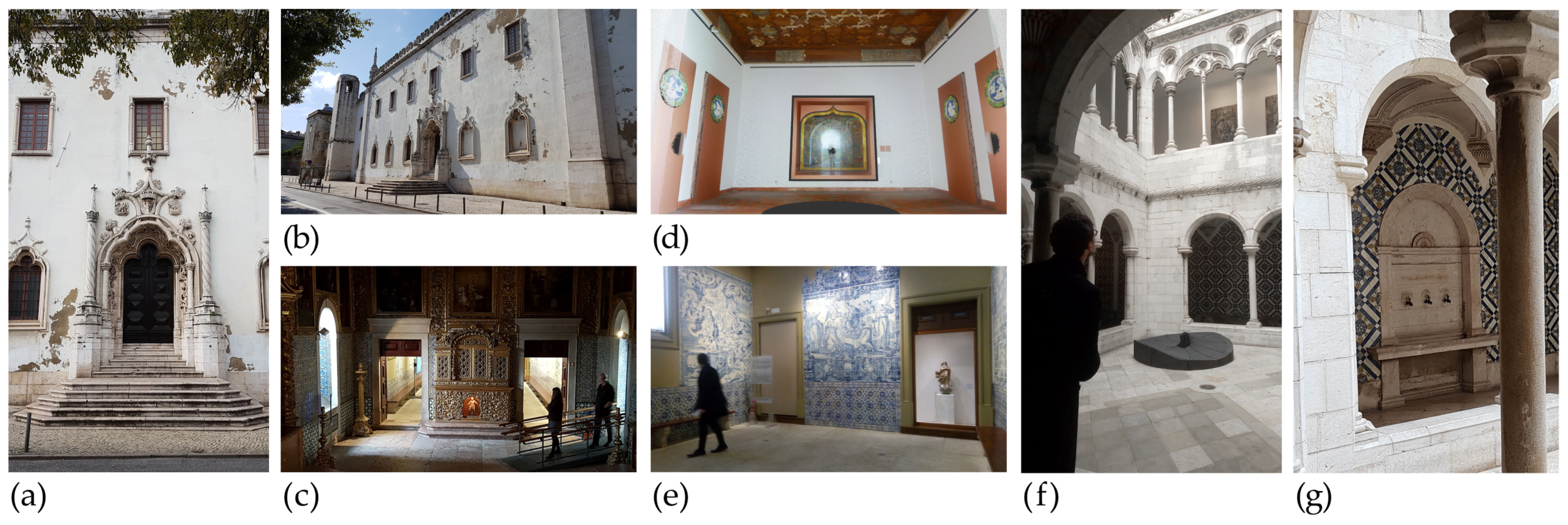

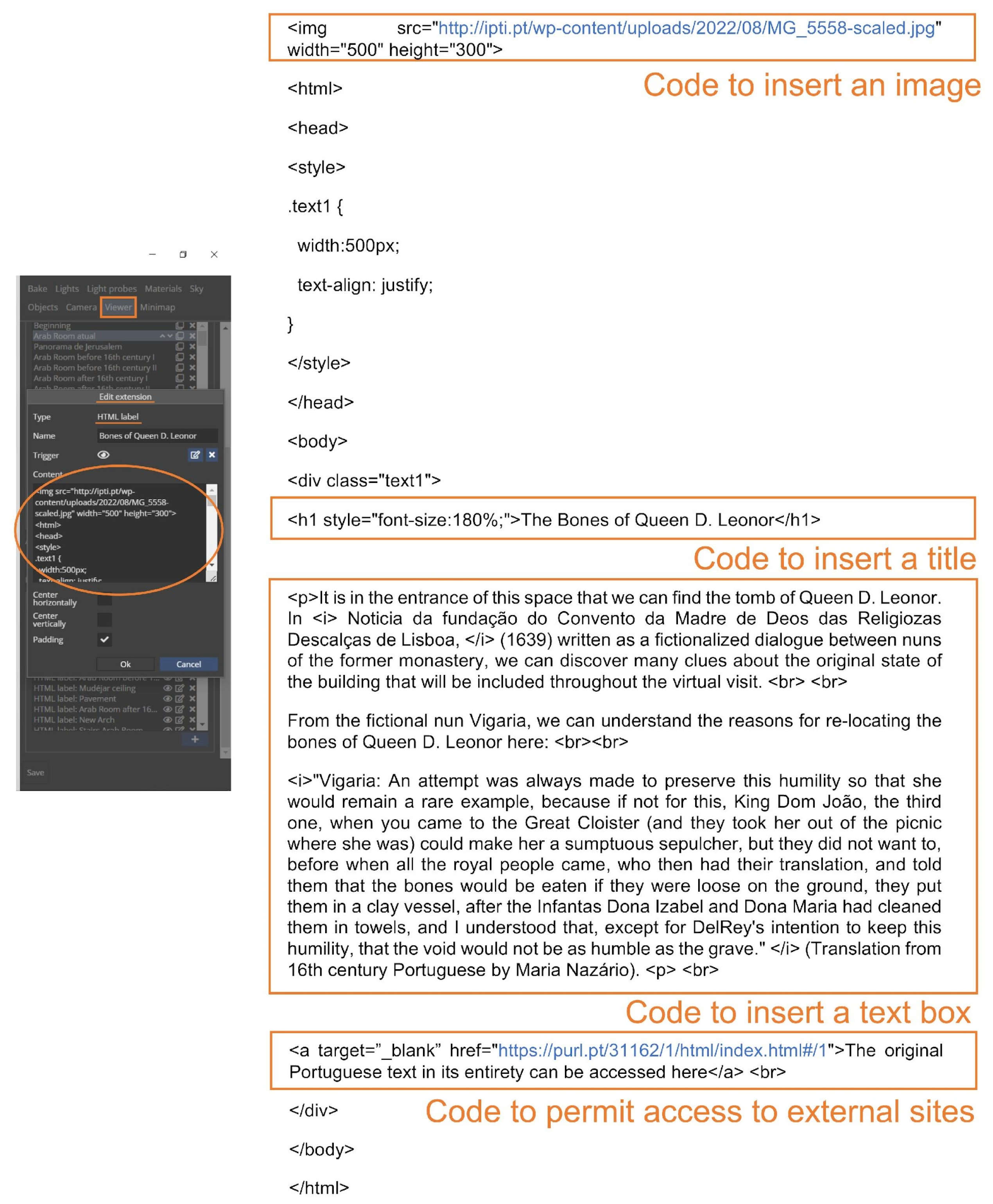
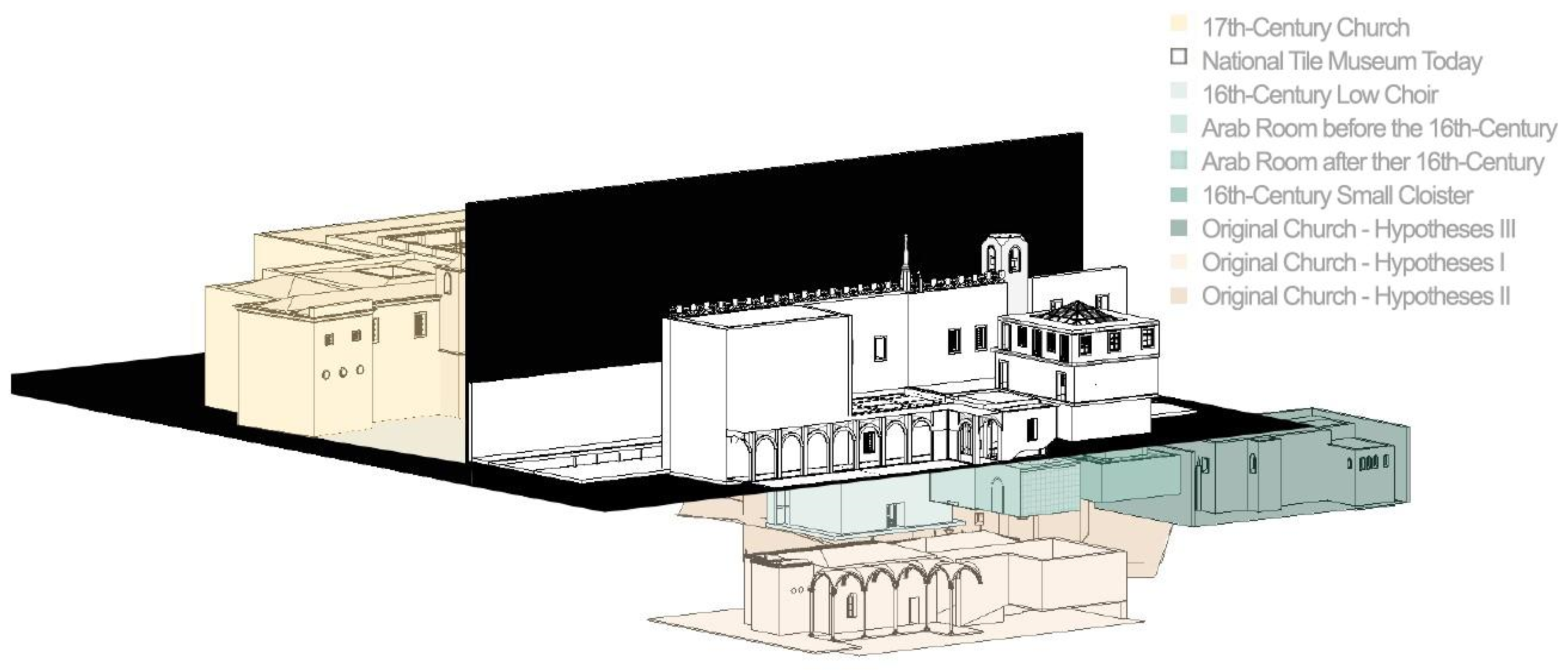
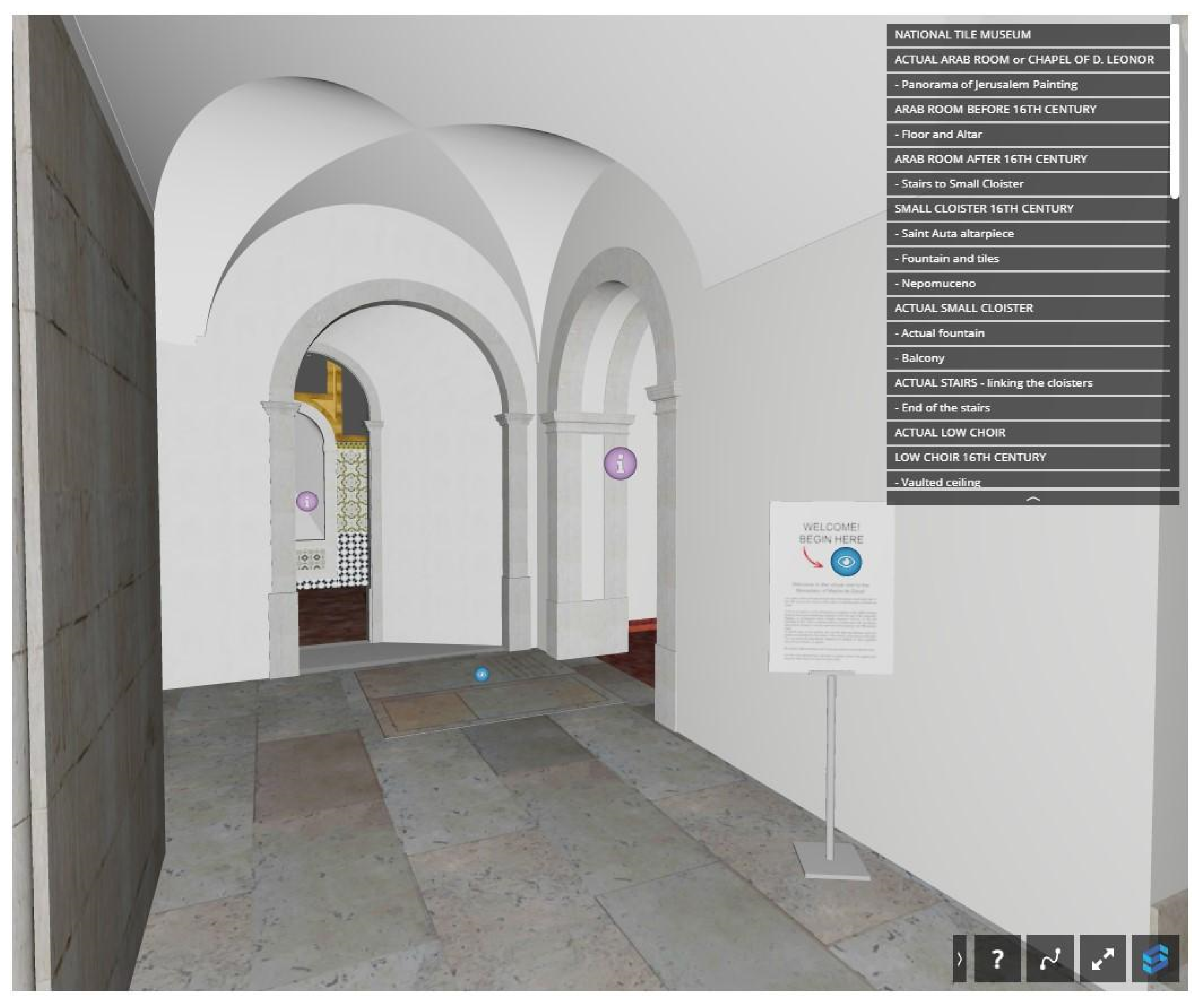
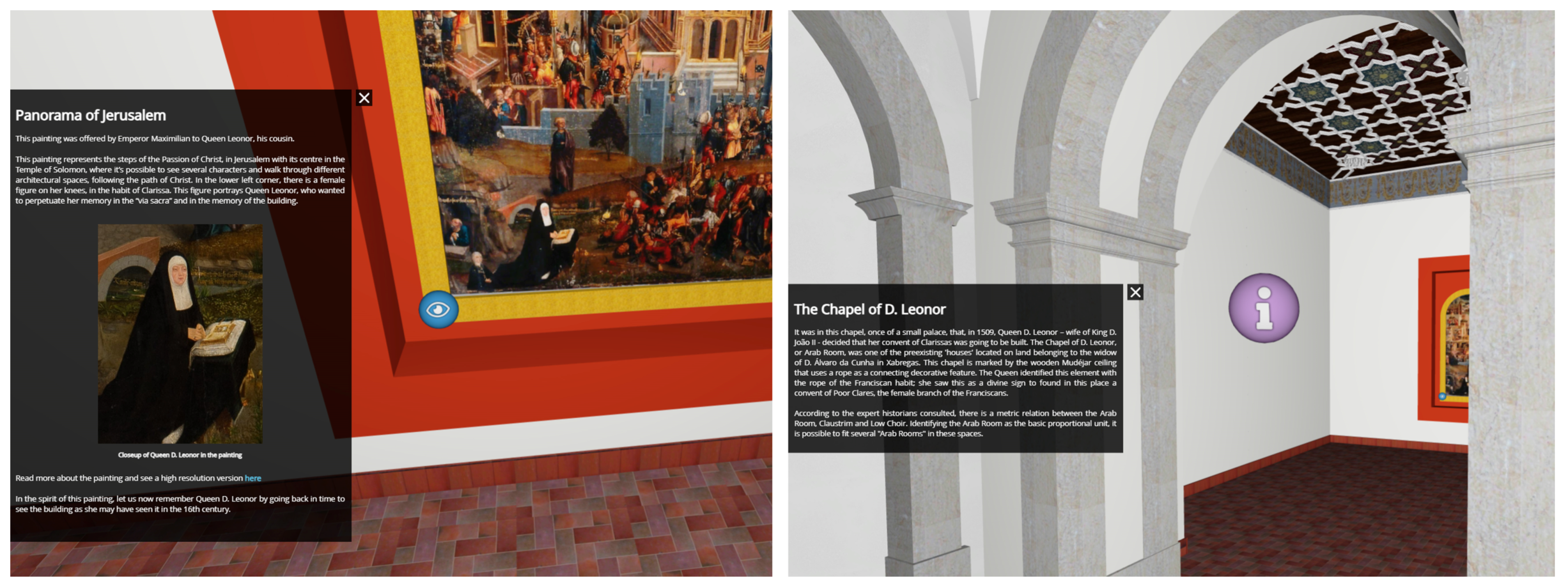
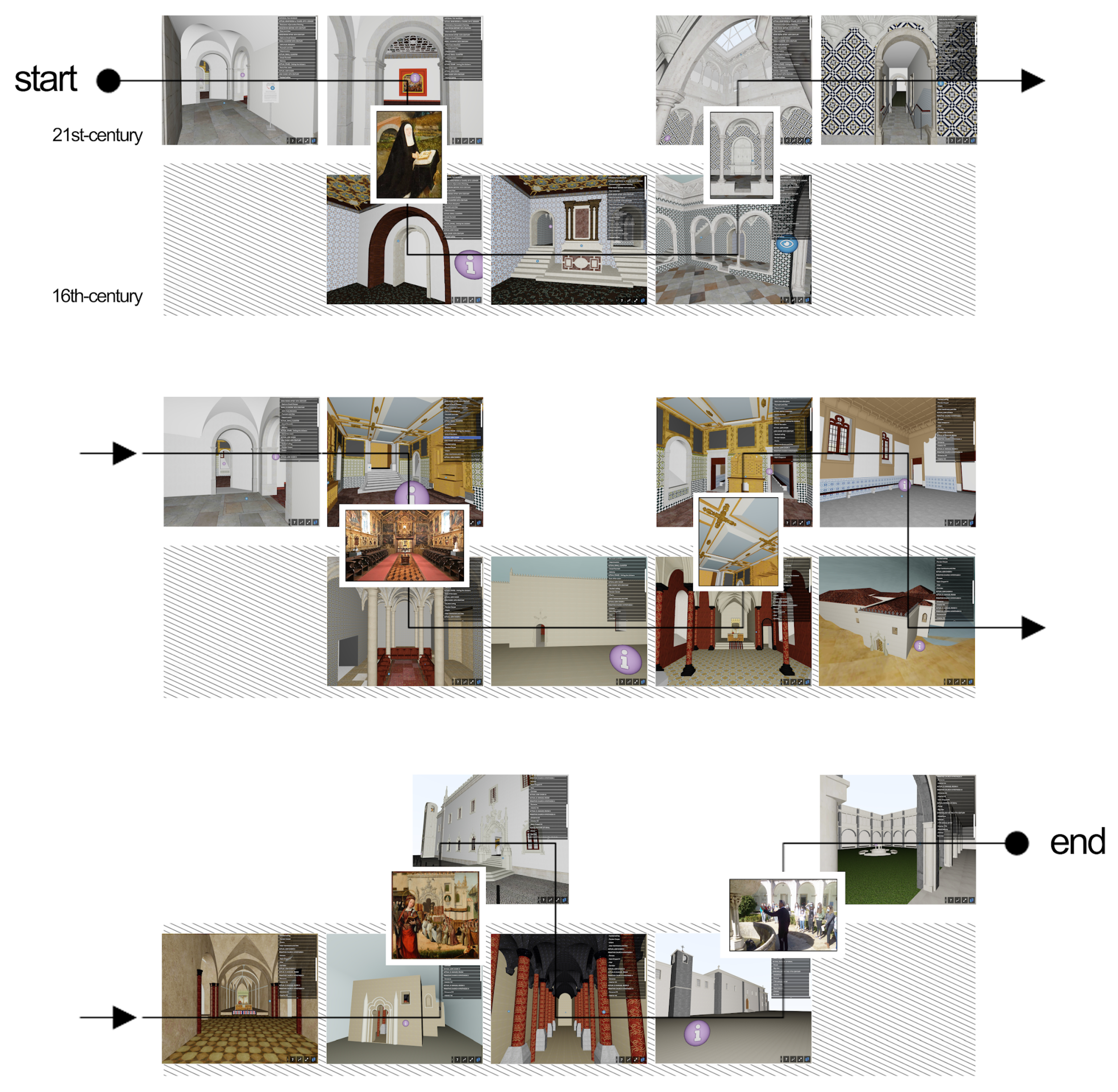
Disclaimer/Publisher’s Note: The statements, opinions and data contained in all publications are solely those of the individual author(s) and contributor(s) and not of MDPI and/or the editor(s). MDPI and/or the editor(s) disclaim responsibility for any injury to people or property resulting from any ideas, methods, instructions or products referred to in the content. |
© 2024 by the authors. Licensee MDPI, Basel, Switzerland. This article is an open access article distributed under the terms and conditions of the Creative Commons Attribution (CC BY) license (https://creativecommons.org/licenses/by/4.0/).
Share and Cite
Rafeiro, J.; Tomé, A.; Nazário, M. Immersive Learning for Lost Architectural Heritage: Interweaving the Past and Present, Physical and Digital in the Monastery of Madre de Deus. Sustainability 2024, 16, 1156. https://doi.org/10.3390/su16031156
Rafeiro J, Tomé A, Nazário M. Immersive Learning for Lost Architectural Heritage: Interweaving the Past and Present, Physical and Digital in the Monastery of Madre de Deus. Sustainability. 2024; 16(3):1156. https://doi.org/10.3390/su16031156
Chicago/Turabian StyleRafeiro, Jesse, Ana Tomé, and Maria Nazário. 2024. "Immersive Learning for Lost Architectural Heritage: Interweaving the Past and Present, Physical and Digital in the Monastery of Madre de Deus" Sustainability 16, no. 3: 1156. https://doi.org/10.3390/su16031156
APA StyleRafeiro, J., Tomé, A., & Nazário, M. (2024). Immersive Learning for Lost Architectural Heritage: Interweaving the Past and Present, Physical and Digital in the Monastery of Madre de Deus. Sustainability, 16(3), 1156. https://doi.org/10.3390/su16031156






